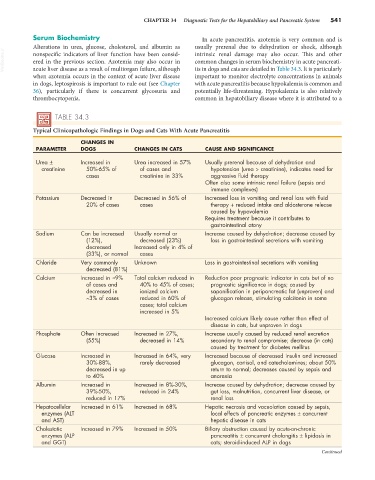Page 569 - Small Animal Internal Medicine, 6th Edition
P. 569
CHAPTER 34 Diagnostic Tests for the Hepatobiliary and Pancreatic System 541
Serum Biochemistry In acute pancreatitis, azotemia is very common and is
Alterations in urea, glucose, cholesterol, and albumin as usually prerenal due to dehydration or shock, although
VetBooks.ir nonspecific indicators of liver function have been consid- intrinsic renal damage may also occur. This and other
common changes in serum biochemistry in acute pancreati-
ered in the previous section. Azotemia may also occur in
acute liver disease as a result of multiorgan failure, although
important to monitor electrolyte concentrations in animals
when azotemia occurs in the context of acute liver disease tis in dogs and cats are detailed in Table 34.3. It is particularly
in dogs, leptospirosis is important to rule out (see Chapter with acute pancreatitis because hypokalemia is common and
36), particularly if there is concurrent glycosuria and potentially life-threatening. Hypokalemia is also relatively
thrombocytopenia. common in hepatobiliary disease where it is attributed to a
TABLE 34.3
Typical Clinicopathologic Findings in Dogs and Cats With Acute Pancreatitis
CHANGES IN
PARAMETER DOGS CHANGES IN CATS CAUSE AND SIGNIFICANCE
Urea ± Increased in Urea increased in 57% Usually prerenal because of dehydration and
creatinine 50%-65% of of cases and hypotension (urea > creatinine), indicates need for
cases creatinine in 33% aggressive fluid therapy
Often also some intrinsic renal failure (sepsis and
immune complexes)
Potassium Decreased in Decreased in 56% of Increased loss in vomiting and renal loss with fluid
20% of cases cases therapy + reduced intake and aldosterone release
caused by hypovolemia
Requires treatment because it contributes to
gastrointestinal atony
Sodium Can be increased Usually normal or Increase caused by dehydration; decrease caused by
(12%), decreased (23%) loss in gastrointestinal secretions with vomiting
decreased Increased only in 4% of
(33%), or normal cases
Chloride Very commonly Unknown Loss in gastrointestinal secretions with vomiting
decreased (81%)
Calcium Increased in ≈9% Total calcium reduced in Reduction poor prognostic indicator in cats but of no
of cases and 40% to 45% of cases; prognostic significance in dogs; caused by
decreased in ionized calcium saponification in peripancreatic fat (unproven) and
≈3% of cases reduced in 60% of glucagon release, stimulating calcitonin in some
cases; total calcium
increased in 5%
Increased calcium likely cause rather than effect of
disease in cats, but unproven in dogs
Phosphate Often increased Increased in 27%, Increase usually caused by reduced renal excretion
(55%) decreased in 14% secondary to renal compromise; decrease (in cats)
caused by treatment for diabetes mellitus
Glucose Increased in Increased in 64%, very Increased because of decreased insulin and increased
30%-88%, rarely decreased glucagon, cortisol, and catecholamines; about 50%
decreased in up return to normal; decreases caused by sepsis and
to 40% anorexia
Albumin Increased in Increased in 8%-30%, Increase caused by dehydration; decrease caused by
39%-50%, reduced in 24% gut loss, malnutrition, concurrent liver disease, or
reduced in 17% renal loss
Hepatocellular Increased in 61% Increased in 68% Hepatic necrosis and vacuolation caused by sepsis,
enzymes (ALT local effects of pancreatic enzymes ± concurrent
and AST) hepatic disease in cats
Cholestatic Increased in 79% Increased in 50% Biliary obstruction caused by acute-on-chronic
enzymes (ALP pancreatitis ± concurrent cholangitis ± lipidosis in
and GGT) cats; steroid-induced ALP in dogs
Continued

